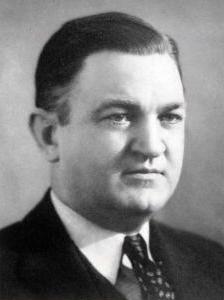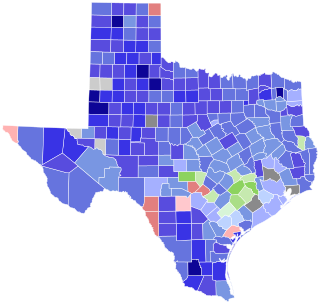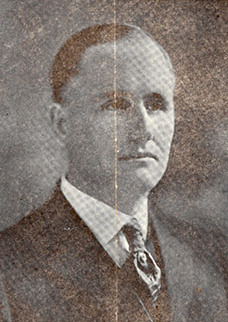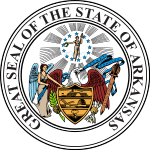
Alfred Mossman Landon was an American oilman and politician who served as the 26th governor of Kansas from 1933 to 1937. A member of the Republican Party, he was the party's nominee in the 1936 presidential election, and was defeated in a landslide by incumbent president Franklin D. Roosevelt.

Carl Edward Bailey was an American attorney and the 31st governor of Arkansas from 1937 to 1941.

Harvey Parnell was an American farmer and politician from Southeast Arkansas. Parnell served in the Arkansas General Assembly for eight years, first in the Arkansas House of Representatives, and later serving a term in the Arkansas Senate. Following the re-establishment of the lieutenant governor position, Parnell won the statewide election and served under Governor John Martineau. When Martineau resigned to take a federal judgeship in March 1928, Parnell was elevated to become the state's 29th governor, a position he would hold until 1933. Early in his time as governor, Parnell was responsible for Progressive reforms popular with rural voters, including expansion and modernization of the highway system and public school reform. But as the Dust Bowl and Great Depression ravaged the Arkansas economy, Parnell's programs were blamed for bankrupting the state, and his popularity plummeted. He left politics after his second full gubernatorial term ended in January 1933.

Thomas Dale Alford Sr. was an American ophthalmologist and politician from the U.S. state of Arkansas who served as a conservative Democrat in the United States House of Representatives from Little Rock from 1959 to 1963.

The 1978 United States Senate elections were held on November 7, in the middle of Democratic President Jimmy Carter's term. The 33 seats of Class 2 were contested in regular elections. Special elections were also held to fill vacancies.

The 1954 United States Senate elections was a midterm election in the first term of Dwight D. Eisenhower's presidency. The 32 Senate seats of Class 2 were contested in regular elections, and six special elections were held to fill vacancies. Eisenhower's Republican party lost a net of two seats to the Democratic opposition. This small change was just enough to give Democrats control of the chamber with the support of an Independent who agreed to caucus with them, he later officially joined the party in April 1955.

The 1938 United States Senate elections occurred in the middle of Franklin D. Roosevelt's second term. The 32 seats of Class 3 were contested in regular elections, and special elections were held to fill vacancies. The Republicans gained eight seats from the Democrats, though this occurred after multiple Democratic gains since the 1932 election, leading to the Democrats retaining a commanding lead over the Republicans with more than two-thirds of the legislative chamber.

The 1936 United States Senate elections coincided with the reelection of President Franklin D. Roosevelt. The 32 seats of Class 2 were contested in regular elections, and special elections were held to fill vacancies. The Great Depression continued and voters backed progressive candidates favoring Roosevelt's New Deal in races across the country. The Democrats gained 5 net seats during the election, and in combination with Democratic and Farmer–Labor interim appointments and the defection of George W. Norris from the Republican Party to become independent, the Republicans were reduced to 16 seats. Democrats gained a further two seats due to mid-term vacancies. The Democrats' 77 seats and their 62-seat majority remain their largest in history.

The 1932 United States Senate elections coincided with Democrat Franklin D. Roosevelt's landslide victory over incumbent Herbert Hoover in the presidential election. The 32 seats of Class 3 were contested in regular elections, and special elections were held to fill vacancies.

The 1996 United States Senate election in Arkansas was held on November 5, 1996. Incumbent Democratic U.S. Senator David Pryor decided to retire. Republican Tim Hutchinson won the open seat, becoming the first Republican to win a U.S. Senate seat in Arkansas since Reconstruction in 1872 and the first to ever be popularly elected in the state. He was the first to win this seat since 1870. Hutchinson lost re-election in 2002 to David Pryor's son Mark Pryor.

Stephen Allen Womack is an American politician serving as the U.S. representative for Arkansas's 3rd congressional district since 2011. The district, which was once represented by former Senator J. William Fulbright, covers much of northwestern Arkansas, including Fort Smith, Fayetteville, Springdale, and Womack's hometown of Rogers. A member of the Republican Party, Womack was mayor of Rogers before his election to Congress.
Osro Cobb was a Republican lawyer who worked to establish a two-party system in the US state of Arkansas. In 1926, he was elected to the Arkansas House of Representatives from Montgomery County and served as the only Republican member in the chamber for two two-year terms. He was the United States attorney for the United States District Court for the Eastern District of Arkansas during the Little Rock Crisis of 1957–1958. He served a year on the Arkansas Supreme Court in 1966 as a temporary appointee of Democratic Governor Orval Faubus.

The 1940 Arkansas gubernatorial election was held on November 5, 1940.

The 1938 Arkansas gubernatorial election was held on 8 November 1938, in order to elect the Governor of Arkansas. Incumbent Democratic Governor of Arkansas Carl E. Bailey defeated Republican nominee Charles F. Cole.

The 1920 Texas gubernatorial election was held on 2 November 1920 in order to elect the Governor of Texas. Former Democratic state representative Pat Morris Neff won comfortably in a four-way race against Republican nominee J. G. Culbertson, American Party of Texas nominee T. H. McGregor, and Black and Tan Republican nominee Hickerson Capers.

West Virginia's 2008 general elections were held on 4 November 2008 with Primary elections being held on 13 May 2008. It saw a landslide Democratic victory across nearly every single office in the state.

The 1934 Arkansas gubernatorial election was held on 6 November 1934, in order to elect the Governor of Arkansas. Incumbent Democratic Governor Junius Marion Futrell was re-elected against Republican nominee G. C. Ledbetter.

The 1928 Arkansas gubernatorial election was held on 6 November 1928, in order to elect the Governor of Arkansas. Democratic nominee and incumbent (Acting) Governor Harvey Parnell defeated Republican nominee Drew Bowers.

The 1924 Arkansas gubernatorial election was held on 4 November 1924, in order to elect the Governor of Arkansas. Democratic nominee and former Arkansas Secretary of State Tom Terral defeated Republican nominee John W. Grabiel.

The 1920 Arkansas gubernatorial election was held on 2 November 1920, in order to elect the Governor of Arkansas. Democratic nominee and former member of the U.S. House of Representatives from Arkansas's 3rd district Thomas Chipman McRae defeated Republican nominee Wallace Townsend.




















